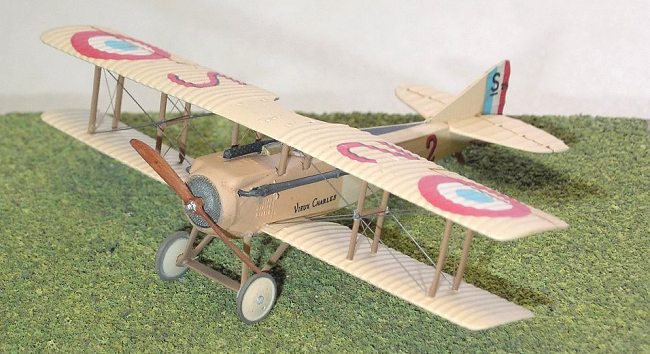
Airfix 1/72 SPAD VII
|
KIT # |
0081 |
|
PRICE: |
$4.48 |
|
DECALS: |
“Le Vieux Charles” of Capitaine Georges Guynemer |
|
REVIEWER: |
Clarence Wentzel |
|
NOTES: |

|
HISTORY |
The French industrialist Armand
Deperdussin started the famous S.P.A.D. company to initially design and produce
a line of streamlined monoplane racers. When Deperdussin was arrested for a
number of questionable financial dealings, a group of industrialists headed by
Louis Bleriot purchased the assets of the company, keeping the talented design
staff in place. As WW I started, the company initiated work on military
designs. The first production military aircraft by the SPAD works was the
strange looking two place A.2 with the observer or gunner located in a pod in
front of the engine. The A.2 was not a
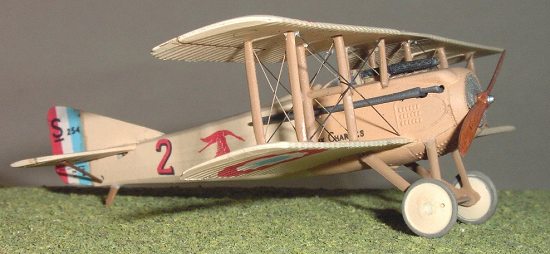 great success but it resulted in the
development of several features that became design characteristics for
subsequent SPAD aircraft – long, thin single bay wings with a narrow gap and an
additional set of interplane struts located where the flying wires crossed.
great success but it resulted in the
development of several features that became design characteristics for
subsequent SPAD aircraft – long, thin single bay wings with a narrow gap and an
additional set of interplane struts located where the flying wires crossed.
In response to a French General Headquarters’ request for an aircraft designed around the 150-hp Hispano-Suiza engine, the SPAD engineers developed what would become the SPAD VII. The development of the aircraft was longer than expected but when production got under way, one of the first SPAD VIIs was assigned to the popular ace Georges Guynemer of the famous Cigones squadron. He flew the airplane in combat for the first time on 4 September 1916 and scored his fifteenth victory. He fell in love with the SPAD and reported that “She loops wonderfully. Her spin is a bit lazy and irregular, but deliciously soft”. The airplane was also noted as one of the best diving aircraft of the war plus it could take a good deal more punishment than other fighters and remain in the air.
In the spring of 1917, the more powerful 180-hp Hispano-Suiza engine became available for the SPAD VII. The first aircraft produced with this engine, number S.254, was assigned to Guynemer and was his third SPAD. He scored nineteen of his victories in this airplane. This historic aircraft still exists and is on display at the Air and Space Museum at Le Bourget. The SPAD VII was exported to various countries and was popular in many air forces.
|
THE KIT |
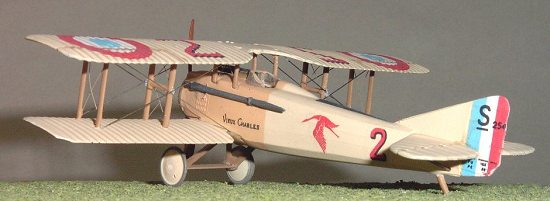 The instruction sheet for this model has a copyright
date of 1988 but I am sure that Airfix initially issued the kit long before that
date. The model appears to be basically accurate in overall length and
wingspan. The tips of the tail surfaces are slightly rounded where they should
be pointed but they are the right size and don’t look too bad. In line with
many kits of the 60’s, the cockpit consists of a bar and a pilot to mount on the
bar. The most glaring problem with the kit is the simulation of the fabric
covered wing surfaces. Deep “trenches” are provided between each rib. This is
much too deep to be scale. The wings also featured a very noticeable ejector pin
marking on the bottom surfaces.
The instruction sheet for this model has a copyright
date of 1988 but I am sure that Airfix initially issued the kit long before that
date. The model appears to be basically accurate in overall length and
wingspan. The tips of the tail surfaces are slightly rounded where they should
be pointed but they are the right size and don’t look too bad. In line with
many kits of the 60’s, the cockpit consists of a bar and a pilot to mount on the
bar. The most glaring problem with the kit is the simulation of the fabric
covered wing surfaces. Deep “trenches” are provided between each rib. This is
much too deep to be scale. The wings also featured a very noticeable ejector pin
marking on the bottom surfaces.
The kit includes a molded windscreen and features decals to produce Capitaine Georges Guynemer’s famous S.254.
|
CONSTRUCTION |
Construction started with the fuselage. To improve the detail level, I added a simple instrument panel, a joystick, some simulated stringers and controls along the inside of the fuselage and a photo-etched pilot seat. I also added a photo-etched cooling jacket to the machine gun.
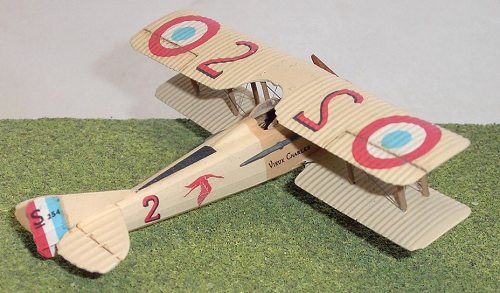 I sanded the top and bottom surfaces of the wings, which
improved the appearance slightly, but the rib trenches are still major
appearance items. I tried to fix the ejector pin flaw but the combination of
curved wing surface and rib trenches made this very difficult to completely
eliminate.
I sanded the top and bottom surfaces of the wings, which
improved the appearance slightly, but the rib trenches are still major
appearance items. I tried to fix the ejector pin flaw but the combination of
curved wing surface and rib trenches made this very difficult to completely
eliminate.
A good feature of the Airfix kit is the biplane wing-mounting scheme. Instead of individual struts, the interplane and cabane struts are molded in an inverted “U” shape and mount into slots molded into the underside of the top wing. This fixes the struts into place so that the top wing can easily be mounted onto the fuselage and bottom wing. A fair amount of trimming and fitting is required so that the bottom of the “U” fits completely into the slot, is even with the bottom surface of the wing and the struts are all parallel. When this is complete, however, the upper wing will accurately fit the mounting positions in the bottom wing and fuselage. An added advantage to the “U” shape of the struts is that the fore and aft bracing wires can be added to the struts before assembly. These would be almost impossible to add after assembly.
The remainder of the assembly is without problems. The undercarriage consists of five parts that went together without problems. The front of the nosepiece is plain, without any simulation of a grille or slats etc. I cut a piece of fine brass screen for this area to improve the appearance. I’m not sure it is 100% accurate but it does look better. The exhaust system and tail bracing parts fit well although a couple of the mounting holes in the fuselage needed opening.
|
CAMOUFLAGE & MARKINGS |
The factory finish of the SPAD appeared to be
uncamouflaged – clear doped - but in reality the fabric surfaces were covered
with a pale pigmented yellow/beige dope. The metal surfaces were coated with a
slightly darker light brown paint. Airfix recommend Humbrol 103 – cream and 94
– yellow brown for the colors. I used Testors Model Master 1709 Radome
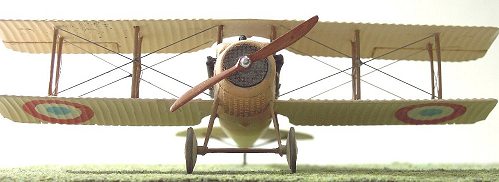 Tan and
2102 Afrika Braun for these purposes. The colors seem to match well and the
final product looks correct. The decal sheet contains all of the markings for
“Le Vieux Charles”. The decals went on easily and set readily into the canyons
between the ribs. The color was accurate for the French insignia except that
they provided a red leader’s pennant for the top of the fuselage. This should
be black as noted on page 22 of the SPAD VII Aces book.
Tan and
2102 Afrika Braun for these purposes. The colors seem to match well and the
final product looks correct. The decal sheet contains all of the markings for
“Le Vieux Charles”. The decals went on easily and set readily into the canyons
between the ribs. The color was accurate for the French insignia except that
they provided a red leader’s pennant for the top of the fuselage. This should
be black as noted on page 22 of the SPAD VII Aces book.
I painted the prop using a technique that I had tried on the fuselage of my Albatros. The prop was painted wood and then Futured. When this was dry, a small amount of Burnt Sienna oil paint was applied with a stiff brush. The brush is drawn along the prop blade to form the effect of wood grain. The tires of WW I aircraft, in common with the technology of the time, were not black but were slightly natural rubber colored. I used a mixture of 2/3 Schwarzgrau and 1/3 Wood to provide this effect. It came out looking right. Most of the flying wires were added using fine stainless steel wire, super glue and care.
|
CONCLUSIONS |
While crude by today’s standards, this kit makes a pleasant little model. With a little care and some simple scratch-built additions, it can add the SPAD VII to your collection, at least until Roden or someone else comes out with a better kit. I enjoy building models of Aces’ aircraft and have always loved the markings of the Cigones squadron so I jumped at the chance when Scott asked me to build this model. Thanks Scott.
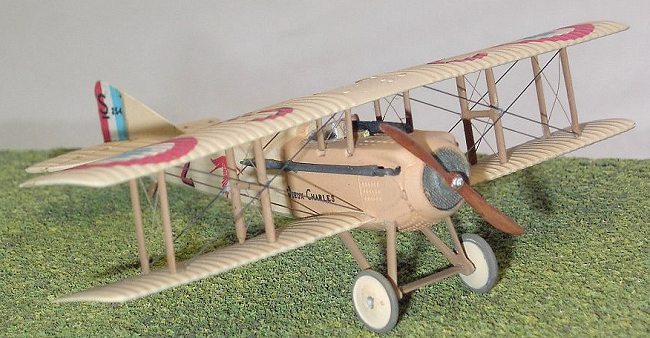
|
REFERENCES |
SPAD Fighters in Action – Squadron Signal Aircraft Number 93
SPAD VII Aces of World War I – Osprey Aircraft of the Aces Number 39
SPAD Scouts S VII – S XIII – Aircam Aviation Series No. 9
French Aircraft of the First World War – Flying Machines Press
Copyright ModelingMadness.com. All rights reserved. No reproduction in any form without express permission from the editor.
If you would like your product reviewed fairly and quickly, please contact the editor or see other details in the Note to Contributors.